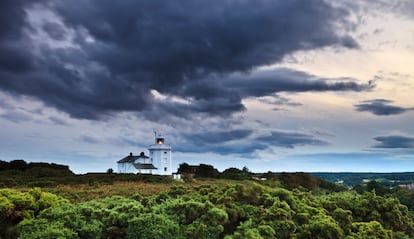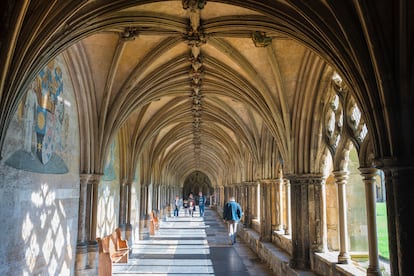Uncovering the attractions of Norfolk, two hours from London and with centuries of history
Agatha Christie and Arthur Conan Doyle based part of their works in the emblematic English county, which hosts the The Broads National Park and historic Norwich

Upon entering the county of Norfolk, less than two hours northeast of London, the impression is that one has entered the deepest part of rural England. That of large meadows, one-lane roads, mansions concealed in the thicket of nature and hidden secrets. Some of these have been revealed by the writers Sir Arthur Conan Doyle and Dame Agatha Christie, who wrote some of their most famous novels in the peaceful environment of Norfolk, where it seems that nothing untoward can possibly happen.
For different reasons, both spent time in Norfolk. Christie maintained a close relationship with the married doctors MacLeod, with whom she had coincided during her archaeological trips to Mesopotamia. The McLeods had a property in the secluded town of North Walsham, where the writer visited them, enjoyed their evening gatherings, wrote, and collected medical and forensic data that she included in her novels. The former McLeod mansion is today the coquettish Beechwood Hotel, which houses her works, letters from friends, photos from that era and anecdotes that ebb and flow in the air.
As for Conan Doyle, it is worth noting that the first case subjected to the deduction of his famous detective Sherlock Holmes, The adventure of the ‘Gloria Scott,’ was conceived in what is now The Broads National Park. The largest wetland in the United Kingdom contains a network of navigable rivers and lakes between the counties of Norfolk and Suffolk across some 115 square miles. Conan Doyle once spent a summer there, visiting a friend who lived in a marsh cottage, with many examples remaining in the area. Most of the houses on the water’s edge are characterized by thatched roofs and a boat at the door and the lakes are frequented by windsurfers and sailors. It is also a paradise for ornithologists that contains a variety of fauna, including the graceful red deer.
The picturesque coastline stretching along the North Sea is dotted with villages of irregular cobblestone houses and cruciform churches of Norman architecture. The bucolic and historic setting, close to the capital, turned Norfolk into a popular English summer resort in the early 19th century, especially in those enclaves by the sea where people enjoyed the beach and fishing as well as dining on the local seafood, including crabs sold at market stalls and cones of cockles, prawns, and lobsters.

Aristocratic Cromer
Cromer is one of the most renowned towns in the area due to the Victorian mansions of the English aristocracy and its 130-meter pier, where visitors fish for crabs and, in the evening, go to the Cromer Pier Pavilion Theater to watch a musical show or a cabaret on the only stage in the world located at the end of a breakwater. The lifeboat station, of which the local population is proud, enjoys widespread fame and was the base of legendary lifeboatman Henry Blogg, who saved hundreds of people during his 53-year career, for which he was decorated on several occasions and has now been honored with his own museum. Another of Cromer’s unmissable attractions is its octagonal lighthouse, which dates to 1883 when Trinity House erected it. Today the lighthouse keeper’s house is available to rent for vacations.
Conan Doyle also visited Cromer. Returning from South Africa, where he was a correspondent during the Boer War, suffering from fevers he came to this seaside town for curative purposes. During a dinner at Cromer Hall, he had the good fortune to meet the philanthropist and politician Benjamin Bond Cabbell, who told him about his ancestor Richard Cabell - Lord of Brook Manor and Buckfastleigh – who is believed to have provided the basis for the dastardly Hugo Baskerville in one of Holmes’ most famous cases, The Hound of the Baskervilles (1902). Hill House Hotel, in the nearby seaside village of Happisburgh, also provided Conan Doyle with inspiration for The Dancing Men, a short story he wrote while staying at this emblematic place. Today it has been converted into a cozy pub, The Hill House Inn. The story was included in the collection The Return of Sherlock Holmes (1905), after Doyle, blaming his detective for overshadowing his other works, had killed Holmes off at the hands of Professor Moriarty in The Final Problem (1893).

Norwich, a medieval postcard
Norwich, the capital of the county of Norfolk, is like a medieval postcard. Its importance dates to the 16th and 17th century and the textile trade, especially in wool. This story is recounted by the Norwich Museum in Bridewell, an old merchant’s house that has been restored to chronicle the rise of the city during the 14th century.
The Wensum River runs through Norwich from the Broads National Park, in which the city and its secluded streets, antique shops, cafes and picturesque market are nestled, in addition to The Ivy Norwich Brasserie, part of the famous London restaurant’s spin-off chain, and cultural attractions such as the Sainsbury Center for Visual Arts, a project by the renowned architect Norman Foster converted into a high-tech museum and art gallery. Among the avant-garde murals that adorn Norwich’s streets are works by Banksy. The highlight of the city though is its impressive 11th-century cathedral, considered a key construction of the English Norman period. Among other peculiarities, it has the only two-story cloister in England, full of ancient carvings and sculptures.
A good way to wave goodbye to endearing Norfolk is aboard the Poppy Line, whose station, in the coastal town of Sheringham, is a return to Britain’s Victorian past. The steam train sounds its whistle and loads its passengers, who will enjoy a bucolic journey along the coast to the town of Holt.

Sign up for our weekly newsletter to get more English-language news coverage from EL PAÍS USA Edition
Tu suscripción se está usando en otro dispositivo
¿Quieres añadir otro usuario a tu suscripción?
Si continúas leyendo en este dispositivo, no se podrá leer en el otro.
FlechaTu suscripción se está usando en otro dispositivo y solo puedes acceder a EL PAÍS desde un dispositivo a la vez.
Si quieres compartir tu cuenta, cambia tu suscripción a la modalidad Premium, así podrás añadir otro usuario. Cada uno accederá con su propia cuenta de email, lo que os permitirá personalizar vuestra experiencia en EL PAÍS.
¿Tienes una suscripción de empresa? Accede aquí para contratar más cuentas.
En el caso de no saber quién está usando tu cuenta, te recomendamos cambiar tu contraseña aquí.
Si decides continuar compartiendo tu cuenta, este mensaje se mostrará en tu dispositivo y en el de la otra persona que está usando tu cuenta de forma indefinida, afectando a tu experiencia de lectura. Puedes consultar aquí los términos y condiciones de la suscripción digital.
More information
Archived In
Últimas noticias
Most viewed
- Sinaloa Cartel war is taking its toll on Los Chapitos
- Oona Chaplin: ‘I told James Cameron that I was living in a treehouse and starting a permaculture project with a friend’
- Reinhard Genzel, Nobel laureate in physics: ‘One-minute videos will never give you the truth’
- Why the price of coffee has skyrocketed: from Brazilian plantations to specialty coffee houses
- Silver prices are going crazy: This is what’s fueling the rally










































